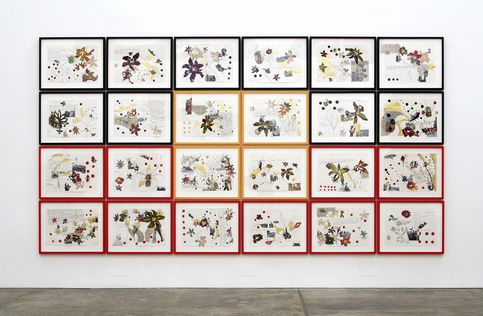Alien Flag Drawings

Yinka Shonibare
Alien Flag Drawings, 2011
Installation 24 drawings and collages on paper, Ink, Cotton fabric with Dutch-Wax-batik printing, found paper, 22 carat gold leaf, approx. 54 x 74.5 cm each, framed 76 x 95 cm each Total dimensions: approx. 310 × 580 cm
GF0031834.00.0-2021
Artwork text
The Generali Foundation Collection owns Alien Flag Drawings, 2011, a large-scale 24-part wall installation in which Shonibare addresses the problem of migration in the 21st century. He keeps alive the events of 2001 surrounding more than 400 boat people who were in acute distress in August as they traveled from Indonesia to Australia. They were rescued onto the Norwegian container ship "Tampa," but then Australian authorities refused to allow the ship to dock ashore and refused the refugees humanitarian admission, as well as all other care, such as medical assistance. A humanitarian catastrophe was brewing, as not even the Australian Red Cross was allowed on board. Three countries got into a dispute over the fate of the refugees: Australia, Indonesia and Norway. Australia dispatched a heavily armed military unit with orders to capture the Tampa. Her captain, Arne Rinnan, showed moral courage. In agreement with his shipping company, he persisted in dropping off the refugees in Australia, otherwise the law of the sea and UN conventions would be broken. A broad media discussion was initiated and made headlines in the international media. The fate of the refugees moved world opinion, but marked the shift to a hard-line Canberra refugee policy that helped the government of the day, led by John Howard, win re-election. Eventually, New Zealand and the small island nation of Nauru agreed to accept them. Since the Tampa, as a cargo ship, was not allowed to transport people, Australia sent a navy troopship: the "Manoora". This ship eventually took the refugees to Papua New Guinea, from where they were flown to Nauru and New Zealand. Shonibare used the international coverage of the "Tampa Affair," as well as locations of internment centers for migrants, passenger lists from British ships bound for Australia, and excerpts from court records of the former British colony as source material for the drawings and collages he made himself. The artist designed them in a kind of comic aesthetic. He transforms refugees into fictional aliens and science fiction figures as symbols of xenophobia and the unknown par excellence, giving the works a wickedly ironic touch and countering common prejudices. The 24 drawings and collages, with additional use of Dtuch-Wax fabrics and gold leaf, are the same size and are in solid black, yellow and red lacquered wooden frames. These are the colors of the flag of the indigenous people of Australia and a sign of appreciation for the indigenous people. The sequence of the individual works is also precisely defined in terms of color. The large-format wall installation depicts the flag of the Aboriginal Australians as a subtext. (Doris Leutgeb)
























